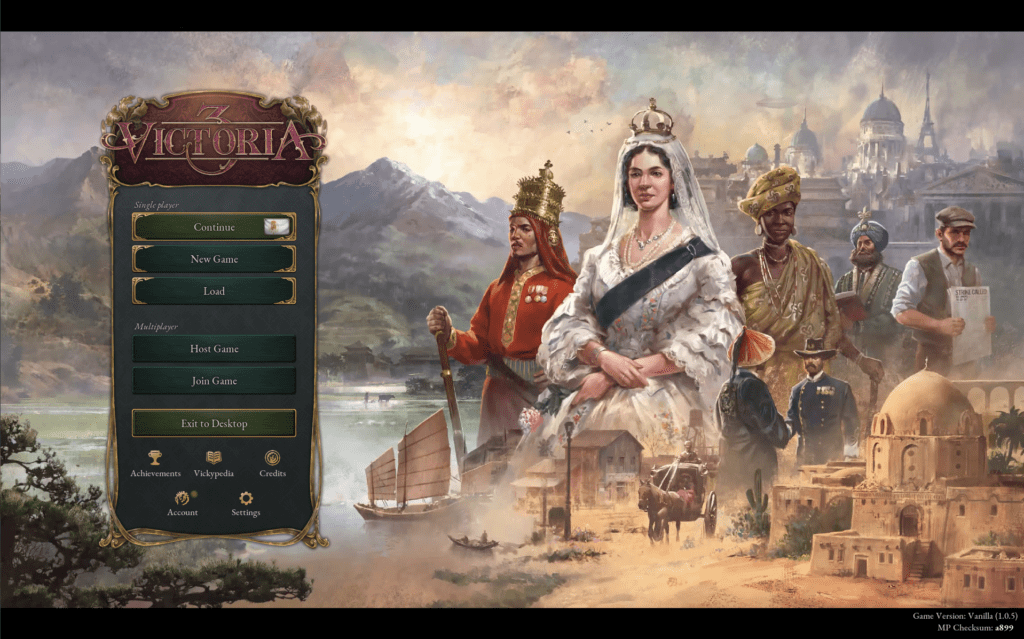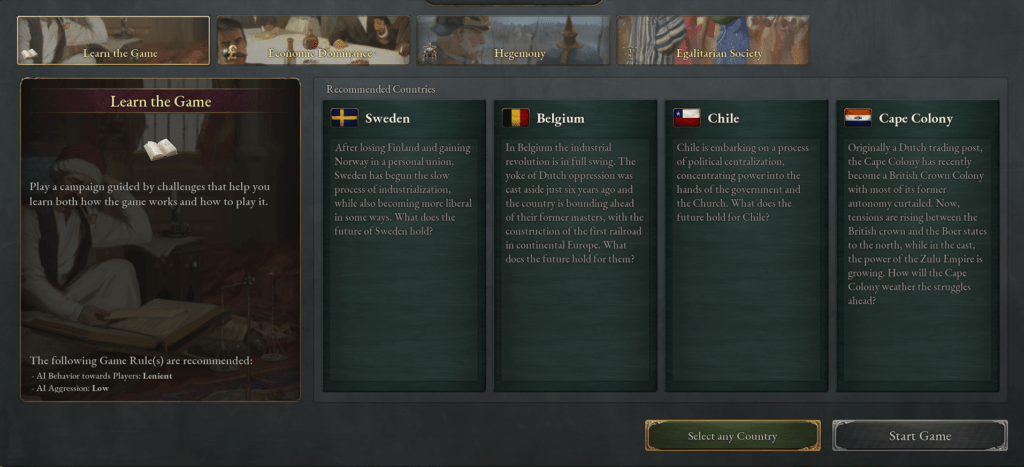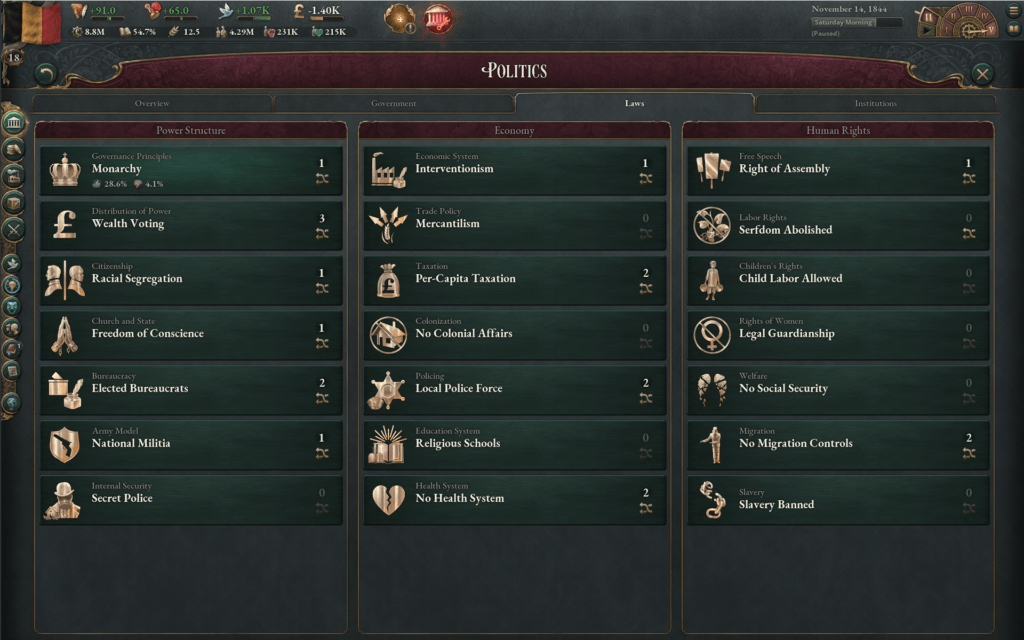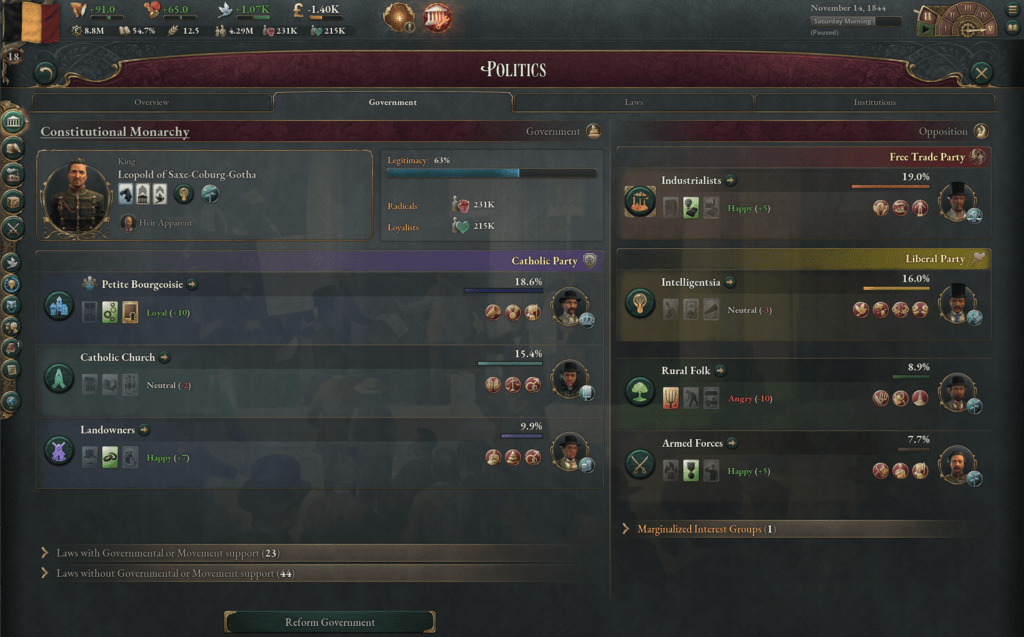You'll love it if:
- You can't wait for your next Paradox game
- You like a game with a steep learning curve.
- You love Grand Strategy games.
Not for you if:
- You want a full, fleshed-out experience.
- You want to just pick up the game and not think too much.
- You don't want to look at a bunch of numbers and modifiers.
Are you ready to be whisked away to the times of industrialization depicted in Victoria 3? When deploying children into work positions or not was a hot debate, and you could force people to work 16-hour shifts in damp and dangerous factories? How about the time when Jack the Ripper was busy sizing up his next victims, and when beautiful sailing clipper ships were about to be phased out in favour of bulky, strong steamships?
The Victorian era, named after Queen Victoria who reigned over England in this time, is a chaotic mess of progress. We have budding new industrialized powers, like Belgium and Brazil, demanding a place on the world stage, fuelled by the new economies of coal and sulphur. We also have the Old world powers, like Spain and England, attempting to stay relevant and struggling to adapt their established economies into the future. All in all, the darkened mists of coal factories and rapidly changing social norms are sure to cause upheaval and unrest in just about every nation. Do you feel you are ready to navigate a nation of your choice into the world’s newest Great Power?

Victoria 3: Gameplay
First things first. Before we dive any deeper, you need to realize that this is a Paradox Interactive game. That means we are knee-deep into their specialty: the Grand Strategy Games. If you believe that this game is a Civilizations-style game or a Tropico-clone, you are going to be sorely disappointed. Opening up Victoria 3 means accepting that you know nothing. You have no clue how to start governing a nation, or how to build economies of scale. If you have played other Paradox Interactive games like; Europa Universalis, Hearts of Iron, Victoria 2, you WILL find the going a little easier. But prepare to be slapped by an epic ensemble of menus, spreadsheets, and in-depth analysis when starting up this game. You have been warned.

Starting out in Victoria 3 is damn hard. Before you even launch the game, Paradox advertises a little video series they made in collaboration with a few YouTubers to help you make sense of the mechanics. We’re talking a nine-part short series just to explain to you the basics of what you are going to be dealing with. If you are serious about this game, I highly recommend checking that out first. After you have some sense of what kind of game mechanics you will be using, and you still want to play your first game? There is a very helpful tutorial game to get you started. In fact, there are 4 basic tutorial games. These will show you the ropes with Sweden, Belgium, Chile, and Cape Colony. After that, you can choose to start a game with a set goal in mind; Economic Dominance, Hegemony, Egalitarian society. In these choices, you are limited to a selection of four nations that historically use this mindset and would make for a good candidate. You could, of course, also opt to go straight into Sandbox mode. There, you can pick any nation that existed at the time and just go to town with your own goals and objectives. Every Victoria 3 campaign starts on January 1st 1836, and ends exactly 100 years later on January 1st 1936.

Victoria 3: Would somebody, please, think of the economy?
In a time when socialism and workers unions were just seeing the light of day, your first ponderable item will be your economy. Depending on what nation you pick, you will face a varying challenge in this regard. The basic premise is the same for every nation however. You must build supply chains to provide your people and businesses with the goods they need. That means you start at basic resources: expanding logging camps, excavating new coal and iron mines. You also need to farm enough wheat, fish and meat to make sure your people don’t get hungry and sad. Once you have that going, you can then start using the surplus to process it into more advanced goods.
I will give you a tip from the get-go. You need wood for essentially everything. The population needs it to start fires and keep themselves warm. Your industries need it to make tools, ships, chairs, and more. The military industry complex needs it to build hardwood, which in turn is used for cannons and guns. Be sure to build enough logging camps, and to keep scaling them throughout your campaign. The demand literally only rises for this good. Tools are a similar example of a processed good. Many industries will need tools to be more efficient, and literally every nation in the world needs tools. Having a surplus can help you make bank.

When the Victoria 3 economy system starts rolling, it feels incredible. You are constantly balancing so many supply lines and everything from basic resources to luxury goods, that it can get overwhelming. But getting it down is incredibly worthwhile. Having enough gold reserves, and sustaining a high standard of living in your country, are two key points to be successful. You will feel incredibly powerful when you pull it off, and the effects’ spillover in your military capabilities and influence on the game world. You see entire population strata’s living the good life on your collective hard work. But it will take time to learn and master this mechanic. Your economy is intrinsically linked to the world economy, as well as whichever nations you decide to trade with.
I have managed to build up Belgium as the number one GDP in the world, surpassing nations like the US of A, England and Russia. But the entire time I was doing it, it felt like I was a driving a steam powered coal train, chugging smoke along the tracks. The economy can start to scale so fast, you are struggling just to keep up with development. After a while, I’m still not sure when or where, my proverbial coal train caught fire and was now barrelling down the tracks like a bat out of hell, spewing darkened flames across the nation. Immigrants from all over the world started migrating to my two-provincial Belgium, looking to partake in that bountiful quality of life. At first, this was incredibly welcome, because it means more and fresher bodies to fill in all kinds of open vacancies in my factories. But it also strained my supply lines, and I started suddenly running out of most crucial goods at alarming speeds. At this point, I had lost all control, and eventually my gold reserves were nosediving so hard I had to declare bankruptcy. The economy, it’s a fickly thing, I tell ya.


While it’s fun to spend some time trying to get your economy going, it can feel incredibly daunting and taxing at a time. My biggest gripe, in this regard, is that there is a LOT of micromanagement. You are essentially managing every single supply chain from infancy to luxury, manually deciding which industries use which kinds of technology to produce goods (and this province specific, not nationally!). That means an insane amount of buttons to be pressed and development to be kept up with. I believe that the basics are there, but Victoria 3 really needs more automatization in this regard. Paradox told us that we would be too busy managing our country to really go to war. But if that means that I am too busy trying to sort out manufactures for a new style of paper production in an attempt to stave off rebellion, then you kinda missed the point Paradox. That is busy work, not very fun, but absolutely necessary. Let an A.I. handle that for me, please.
The second-biggest gripe, is that most economies feel and play the same. Sure, some goods are taboo, like opium in China. Or other cultures are obsessed with goods, like the English and tea. But other than these minor differences, every economy plays out the exact same way. I don’t really feel like I am doing a lot different between Two Sicilies, Netherlands, or a Spain campaign. You try to rear the economy towards profit, by building supply lines. No matter who sits on the throne, or if you even have a throne. Everything else makes it easier or harder to do, but in the end, the economy is all there is. At present, there is not enough flavour content or nation specific mission trees (like EU4 or HOI4) to make it really feel like you are involved in that culture or its people.

Victoria 3 Politics: Forming governments, pushing laws, and the occasional scandal
Another huge part of gameplay in Victoria 3, are your interest groups. Some of these might get a flavoured and thematically appropriate name, but they will work the same everywhere. If you keep the interest groups aligned with you, they will give you powerful bonuses. To do that, you must favour them in any event choices, as well as push for legislation that they stand for. For example, the Catholic Church is all for helping the sick and the poor, but you will feel their wrath when you try to make women employable. The intelligentsia is not a big fan of you building out a secret police, but they laud any chance to make the people more literate.
So as you may have guessed already, you will not just be balancing the economy, you will also be balancing the politics. In election based countries, you will need to reform the government every few years by switching out parties based on their ‘clout’ or influence they wield. You’ll want a government that accurately represents the people, because that gives your government legitimacy for pushing new laws with increased speed. At the same time, you don’t want the government to be too big and unwieldy, or you will not get anything done. Laws can be debated over, if you have a parliament, which will fire off related events in which your monarch can take a stance. All in all, you will want the right parties to be a part of your government, so you take the legal direction for the nation that you envision. But that must eternally be balanced with how powerful and representative the parties are.

All in all, the Victoria 3 politics are a nice distraction of scaling your economies. I found myself rooting for the push-through of some new legislation I needed. I spent a lot of my authority and bureaucracy points (two of your four currencies in this game) to get the countries where I believed they needed to be. Once we finally had a dedicated police force, with a secret police to boot and a militarized national guard, we managed to catch The Ripper of Brussels serial killer! Unfortunately, he turned out to be an influential political party head, who was a staunch supporter of my government and king. Goshdarnit. It’s always the ones you least expect, isn’t it?
Victoria 3’s Diplomacy and War
If you want to play with the big boys in the world stage, you will also need to master diplomacy and war in Victoria 3. Now, these parts are definitely the least fleshed out parts as far as I am concerned. Let me elaborate. To perform anything on the world theatre, you will need to declare your nation’s interests. For example, you could be playing as the Ottoman Empire, and you declare that your nation has an interest in the Italian peninsula. Other countries will do the same, and now you will have a grouping of nations that are interested in the same lands, which make them naturally enemies. Like Scots and other Scots.

Next, you will open a diplomatic play. Which sounds fancy, but it really isn’t. As the Ottomans, you would then go Two Sicilies, and tell them you want a certain province, Like Palermo. The diplomatic play will then go through three phases. The first is the opening phase. You have made your demand, so Two Sicilies would now be able to make a counter demand. At the same time, other nations with a declared interest will get notified and be asked if they want to lean towards supporting one side, or stay neutral. After this is completed, we get two to phase two, the escalation phase. At this moment, the involved nations have a little bit of time to start mobilization of armies and navies, assign their generals and open up fronts of attack or defense. It’s still possible for one party to acquiesce, and give the other nation what they want. Once we get to phase three, however, all bets are off. Hostilities are opened and armies start to clash in a meat grinder to gain the upper hand. Navies can stake a naval invasion too. This continues until one party surrenders.

And…that is basically it. You do not get to command your armies yourself, you just tell your general to do one of three things. Idle, defend, or attack. The same can be said for the navies. So the diplomacy feels…lackluster. Like it is still missing some meat on the bones. The way you wage war is just downright disappointing even, especially when compared to other Grand Strategy games by the same company.
Victoria 3 Music and Art
I feel like it would be amiss if I didn’t at least mention the incredibility and beauty of the crafted world. Its splash arts, loading screens, maps and menu’s all feel like the designers have spent many loving hours making it. I absolutely love the art direction this game has nestled in, and I hope they keep it just the same for future content releases!
The music is, it pains me to say, mostly unmemorable. It’s there, but it serves mostly as filler in the background as you attempt your third run as a socialist Spain while France eyeballs you wearily. I hope we’ll see some future updates and content packs in this regard as well, because the game could use a couple of classic bangers.

Victoria 3: Conclusion
The game…good. But for now, that is all it is. I can’t say it’s spectacular or incredible just yet. I feel like it’s a rough cut diamond, acceptable for a first pass, but not exactly ready to install in a ring. The foundations for greatness are all there though. The economic systems are not likely to change, only to be smoothened out with some optimization. The war system right now is underwhelming, as is diplomacy. But Paradox does have a record of releasing their games in a slightly bare-boned state, only to start filling it with expansions and DLC packs until it becomes a true and clean-cut diamond. Victoria 3 is no different in this regard. It’s fun to play, and it will be difficult to master already for a while. But without more content, it’s doubtful I will be playing more than a couple of completed campaigns for a while. Then I’ll just return to Europa Universalis 4 or Hearts of Iron 4, or even Victoria 2 to get a little more depth in my game.
Victoria 3 is available for 49.99€ on the Steam Store, and is available right now! If you need a new keyboard for your Victoria 3 adventures, be sure to check out our SureFire Kingpin M2 review.
Special thanks to the wonderful people @Enarxis Dynamic Media for providing us with a review copy!
